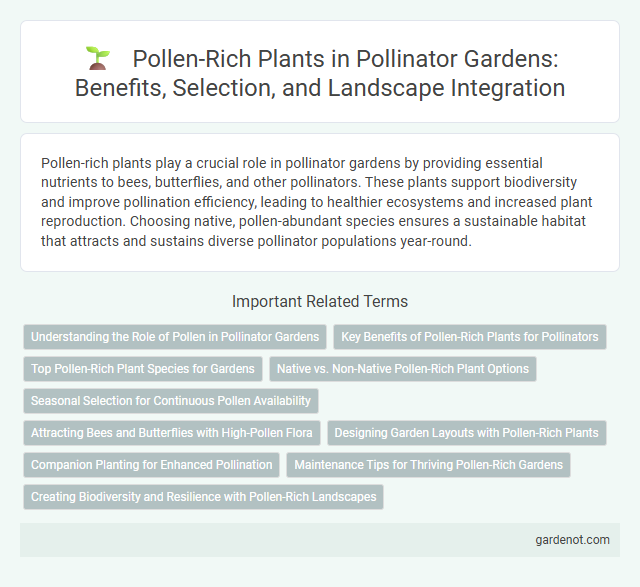Pollen-rich plants play a crucial role in pollinator gardens by providing essential nutrients to bees, butterflies, and other pollinators. These plants support biodiversity and improve pollination efficiency, leading to healthier ecosystems and increased plant reproduction. Choosing native, pollen-abundant species ensures a sustainable habitat that attracts and sustains diverse pollinator populations year-round.
Understanding the Role of Pollen in Pollinator Gardens
Pollen-rich plants are essential in pollinator gardens as they provide vital nutrients for pollinators such as bees, butterflies, and hummingbirds. These plants produce abundant pollen, which serves as a primary protein source necessary for the growth and reproduction of pollinator populations. Integrating a variety of pollen-producing species ensures continuous food availability, enhancing pollinator health and biodiversity within garden ecosystems.
Key Benefits of Pollen-Rich Plants for Pollinators
Pollen-rich plants provide essential nutrition by supplying high-protein pollen critical for the growth and development of pollinators such as bees and butterflies. These plants enhance pollinator health, boosting reproductive success and colony resilience. Incorporating diverse pollen-rich species in pollinator gardens supports ecosystem stability and improves pollination efficiency for surrounding crops and wild flora.
Top Pollen-Rich Plant Species for Gardens
Sunflower (Helianthus annuus) stands out as a top pollen-rich plant species, providing abundant pollen for a wide variety of pollinators including bees and butterflies. Lavender (Lavandula spp.) offers not only fragrant blooms but also a high pollen yield essential for sustaining pollinator populations. Bumblebees and honeybees are especially attracted to these plants, making them indispensable for enhancing biodiversity in pollinator gardens.
Native vs. Non-Native Pollen-Rich Plant Options
Native pollen-rich plants like purple coneflower and goldenrod provide essential nectar and pollen sources that support local pollinators' health and biodiversity. Non-native pollen-rich plants, such as certain varieties of lavender and sunflowers, can complement native species but may not offer the same nutritional value or ecological benefits. Selecting a balance of native and carefully chosen non-native plants enhances pollinator garden diversity while maintaining ecosystem stability.
Seasonal Selection for Continuous Pollen Availability
Selecting pollen-rich plants with staggered bloom times ensures continuous pollen availability throughout the growing season in a pollinator garden. Early spring blooms like crocuses and dandelions provide vital pollen for emerging bees, while mid-summer flowers such as coneflowers and milkweed sustain pollinators during peak activity. Late-season bloomers like goldenrod and asters extend pollen resources into fall, supporting pollinator health and biodiversity year-round.
Attracting Bees and Butterflies with High-Pollen Flora
Pollen-rich plants such as sunflowers, lavender, and coneflowers are essential for attracting bees and butterflies, providing abundant nutrition vital for their survival and pollination activities. These high-pollen flora not only support diverse pollinator populations but also enhance the ecological health of gardens by increasing plant reproduction and biodiversity. Incorporating native pollen-rich species ensures sustainability and optimal attraction for local pollinators, boosting overall garden productivity.
Designing Garden Layouts with Pollen-Rich Plants
Designing garden layouts with pollen-rich plants boosts pollinator activity by providing essential nutrition for bees, butterflies, and other beneficial insects. Prioritize species such as lavender, sunflowers, and coneflowers that produce abundant, accessible pollen throughout the growing season. Strategic placement of these plants in clusters enhances pollination efficiency and supports local biodiversity.
Companion Planting for Enhanced Pollination
Pollen-rich plants such as sunflowers, lavender, and borage thrive when paired with companion plants that attract diverse pollinators like bees and butterflies. Strategic companion planting enhances pollination efficiency by increasing the variety and abundance of pollen sources within close proximity. Integrating flowering herbs and native wildflowers in pollinator gardens supports a robust ecosystem, improving crop yields and biodiversity.
Maintenance Tips for Thriving Pollen-Rich Gardens
Regularly deadhead spent flowers to encourage continuous blooming and enhance pollen production in pollen-rich plants. Ensure soil remains well-drained and enriched with organic compost to support healthy root development and nutrient uptake. Monitor for pests and diseases early, applying eco-friendly treatments to maintain vibrant, thriving pollinator habitats.
Creating Biodiversity and Resilience with Pollen-Rich Landscapes
Pollen-rich plants such as milkweed, coneflowers, and goldenrod play a crucial role in enhancing biodiversity by supporting a wide range of pollinators including bees, butterflies, and hummingbirds. These plants provide essential nutrients that promote pollinator health and improve ecosystem resilience against environmental stresses. Incorporating diverse pollen-rich species into garden landscapes fosters sustainable habitats that enable pollinator populations to thrive and maintain ecological balance.
Pollen-rich plant Infographic

 gardenot.com
gardenot.com